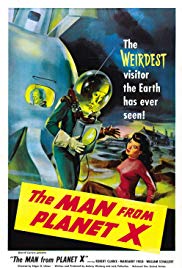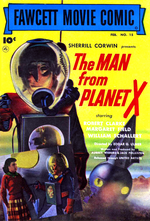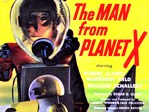The Man from Planet X **** (1951, Robert Clarke, Margaret Field, Raymond Bond, William Schallert) – Classic Movie Review 8234
The 1951 film The Man from Planet X is a surprisingly intelligent, imaginative and entertaining sci-fi horror movie adventure, shot in only a week (or six working days) by the globetrotting, prolific B-movie director Edgar G Ulmer in one of his career highspots.
In the screenplay by the film’s producers Aubrey Wisberg and Jack Pollexfen, Professor Elliot (Raymond Bond) has set up an observatory on a foggy remote Scottish island, helped by his daughter Enid (Margaret Field) and former student Dr Mears (William Schallert). A ship from Planet X lands near the observatory in misty Scotland and a small bodied, big-headed alien spaceman, The Man from Planet X (Pat Goldin), appears and tries to make friends.
Robert Clarke stars as the newsman John Lawrence, who, along with David Ormont as the police inspector Porter and Roy Engel as Tommy the Constable, set out to investigate.
But then, under pressure from Dr Mears, a rotten scientist with a shady past, who has a hidden agenda for trying to communicate with it, the alien turns out not to be so benevolent after all and it is forced to lash out.
Also in the cast are Gilbert Fallman, Tom Daly, June Jeffery, Franklyn Farnum, Harold Gould, Lars Hensen, Ian Murray and Charles Davis. It is Gould’s film debut, uncredited, as Frightened Villager.
The Man from Planet X is directed by Edgar G Ulmer, runs 72 minutes, is made by Mid-Century, is released by United Artists, is written by Aubrey Wisberg and Jack Pollexfen, is shot in black and white by John L Russell, is produced by Aubrey Wisberg and Jack Pollexfen, is scored by Charles Koff, and is designed by Angelo Scibetta and Byron Vreeland. The special effects are by Andy Anderson and Howard Weeks, the photographic effects are by Jack R Glass and the optical effects are by Jack Rabin.
So, as it was shot in a week and the SAG minimum pay was $175 per week, Robert Clarke’s pay was $175 for the entire film, though his final check was $210 with overtime.
Goldin, who plays the spaceman, complained about billing, short pay and the heat of the costume to no avail. He did a slow-motion vaudeville act.
The film started production on 13 December 1950 at Hal Roach Studios in Culver City, California, and wrapped principal photography six days later. Ulmer used sets from the big-budget Joan of Arc (1948) to stretch his tiny budget, which was set at $38,000 and ended up at $41,000. Ulmer used artificial fog to change moods, plot locations, and to hide the lack of backdrops for the outdoor scenes. Ulmer did the rewrites, and designed the moon and spaceship and glass paintings himself, for speed and economy.
It ended up taking $1.2 million at the box office, and has also ended up with a minor cult reputation – not bad for a $41,000 investment.
The musical communication between humans and aliens at the end of Close Encounters of the Third Kind (1977) is modelled after this movie.
Ulmer (1904-72) is best remembered for the 1945 film noir Detour, but he is also known for The Black Cat (1934), The Light Ahead (1939), Isle of Forgotten Sins (1943) and The Man from Planet X (1951).
© Derek Winnert 2019 Classic Movie Review 8234
Check out more reviews on http://derekwinnert.com




